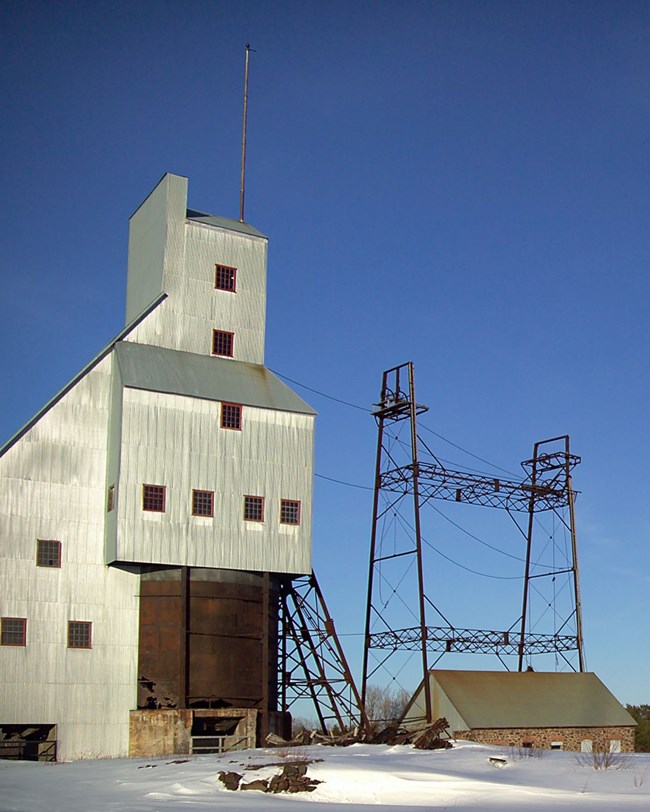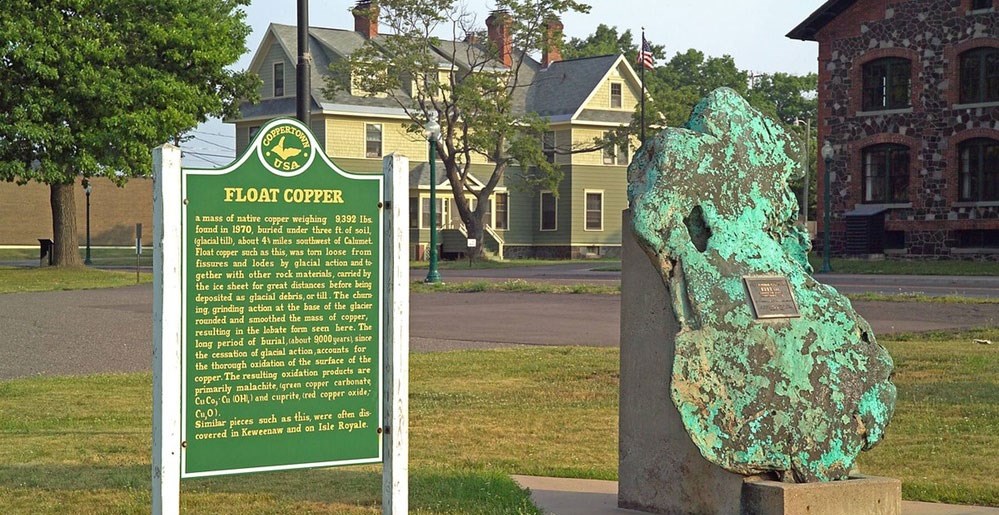Last updated: July 9, 2024
Article
NPS Geodiversity Atlas—Keweenaw National Historical Park, Michigan
Geodiversity refers to the full variety of natural geologic (rocks, minerals, sediments, fossils, landforms, and physical processes) and soil resources and processes that occur in the park. A product of the Geologic Resources Inventory, the NPS Geodiversity Atlas delivers information in support of education, Geoconservation, and integrated management of living (biotic) and non-living (abiotic) components of the ecosystem.

Introduction
Keweenaw National Historical Park (KEWE) is located on the Keweenaw Peninsula in Baraga, Houghton, Keweenaw, and Ontonagon Counties, Michigan. Established on October 27, 1992, KEWE encompasses about 756 hectares (1,869 acres) and includes two primary units, the Calumet Unit and the Quincy Unit (Anderson 2017). The historical park preserves and interprets the story of the rise, domination, and decline of the region’s copper mining industry, beginning with prehistoric activity nearly 7,000 years ago through large-scale industrial mining in the 1800s and 1900s. The Keweenaw Peninsula contains some of the most extensive known deposits of native copper in the world and is one of the only sites in the country where aboriginal mining of copper occurred. Copper artifacts made by American Indians on the peninsula were traded as far south as present-day Alabama. The park’s Keweenaw Heritage Site partners operate most visitor facilities, offering diverse experiences and views of the industry and its participants.
Geologic Setting
The geology of Keweenaw National Historical Park predominantly consists of ancient billion-year-old lava flows associated with the formation of the Midcontinent Rift System of the North American craton (an old, stable part of the continental crust). As regional extensional forces stretched the crust, a rift system developed from at least as far southwest as Kansas through the Lake Superior region and into and beyond southern Michigan that allowed molten rock to migrate upward through fractures and faults. The entirety of the bedrock at KEWE is igneous rocks of the Portage Lake Volcanics, including the igneous units of the Scales Creek, Kearsarge, and Greenstone lava flows. Volcanic activity associated with the Midcontinent Rift produced large-scale economically recoverable native copper that is 97% pure. Evidence of Pleistocene glaciation that advanced and retreated across the Great Lakes region can be found in many locations throughout the Keweenaw Peninsula in the form of kettle lakes, gravel and sand deposits, and glacial grooves in exposed basalt.
Regional Geology
Keweenaw National Historical Park is a part of the Superior Upland Physiographic Province and shares its geologic history and some characteristic geologic formations with a region that extends well beyond park boundaries.
- Scoping summaries are records of scoping meetings where NPS staff and local geologists determined the park’s geologic mapping plan and what content should be included in the report.
- Digital geologic maps include files for viewing in GIS software, a guide to using the data, and a document with ancillary map information. Newer products also include data viewable in Google Earth and online map services.
- Reports use the maps to discuss the park’s setting and significance, notable geologic features and processes, geologic resource management issues, and geologic history.
- Posters are a static view of the GIS data in PDF format. Newer posters include aerial imagery or shaded relief and other park information. They are also included with the reports.
- Projects list basic information about the program and all products available for a park.
Source: NPS DataStore Saved Search 3398. To search for additional information, visit the NPS DataStore.
Related Articles
Keweenaw National Historical Park
National Park Service Geodiversity Atlas
The servicewide Geodiversity Atlas provides information on geoheritage and geodiversity resources and values within the National Park System. This information supports science-based geoconservation and interpretation in the NPS, as well as STEM education in schools, museums, and field camps. The NPS Geologic Resources Division and many parks work with National and International geoconservation communities to ensure that NPS abiotic resources are managed using the highest standards and best practices available.

